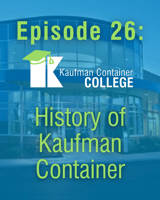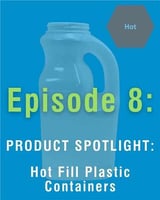Episode 26: History of Kaufman Container This episode of Coffee with Kaufman covers the history of...
Kaufman Container College: Packout Methods - Ensuring Safely Shipped Items from Kaufman Container
In the world of product manufacturing and distribution, the journey from the assembly line to customer's doorstep involves a critical stage called a packout, the final in-house step of packing and shipping your items. This last step ensures that your products are not only securely packed but also protected against the rigors of shipping and transportation to their next location. Let's delve deeper into the various packout methods we offer at Kaufman Container and how they can safeguard your items. Those methods are tumble packed, stack packed, layer packed, cell packed, and bulk packed.
Tumble Packed: 
Tumble packing epitomizes the efficiency and simplicity of filling a box with minimal labor. The components are packed in an unorganized bulk fashion, the way they land into the box. This is the most simple and common form of packing and it is particularly suited for plastic containers or closures where the risk of damage from contact during transit is lower. To further safeguard the products, Kaufman Container often lines the packing box with a polyethylene bag, preventing direct contact between the items and the outer packaging.
Stack Packed: 
For a more organized approach, stack packing arranges bottles or jars upright or on their sides, stacked neatly on top of each other. This method maximizes space efficiency while minimizing movement within the container during transportation. By reducing the gap between the products and the box, stack packing significantly lowers the risk of breakage or damage caused by shifting during transit.
Layer Packed: 
Layer packing introduces an additional protective element within the shipping carton. Typically, materials like corrugated cardboard, paper, or foam are strategically placed between layers of the items. This not only creates physical barriers that shield fragile glass, plastic, or metal items but also absorbs shocks and vibrations during handling and shipping. Layer packing is ideal for products that require extra protection without the need for individual compartmentalization.
Cell Packed: 
Cell packing represents the pinnacle of protection in the packout arsenal. Each finished product is nestled within its own individual cell, typically crafted from sturdy cardboard. These cells span the full length and width of the shipping box, creating a grid-like structure that ensures every item is shielded from all sides. This method is particularly favored for delicate or decorated containers where scratches or dents must be avoided at all costs.
Bulk Packed: 
Bulk packed items are assembled off the production line and grouped tightly together. They are then enveloped in heat shrink-wrap to form a secure module. These modules are arranged on pallets and undergo further heat shrink-wrapping to immobilize them completely during shipping. Bulk packing is not only efficient in terms of space utilization but also guarantees that items arrive at their destination intact and undamaged.
Conclusion:
Choosing the right packout method is essential for maintaining product integrity and customer satisfaction. Regardless of the chosen packout method, Kaufman Container places a strong emphasis on quality assurance. Each step of the packing process is meticulously managed to uphold the integrity of your products. From choosing the appropriate packing materials to ensuring secure assembly and transit, we prioritize the safe delivery of your items.
Next time you’re considering the logistics of shipping your products, remember the importance of a well-executed packout strategy. It’s not just about packing—it’s about safeguarding your brand’s reputation and ensuring a positive experience for our customers. Trust Kaufman Container to handle your packout needs with care and precision, ensuring a smooth and damage-free transfer of your items every time.



